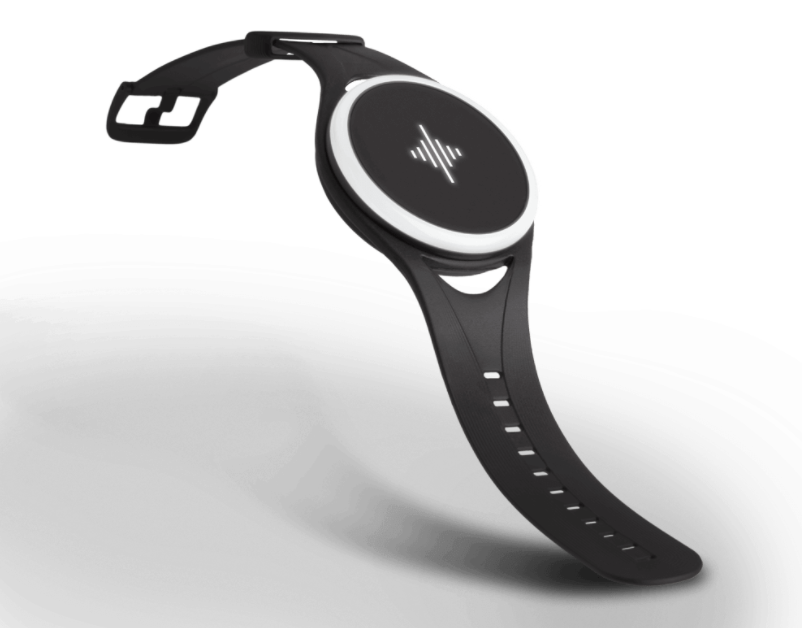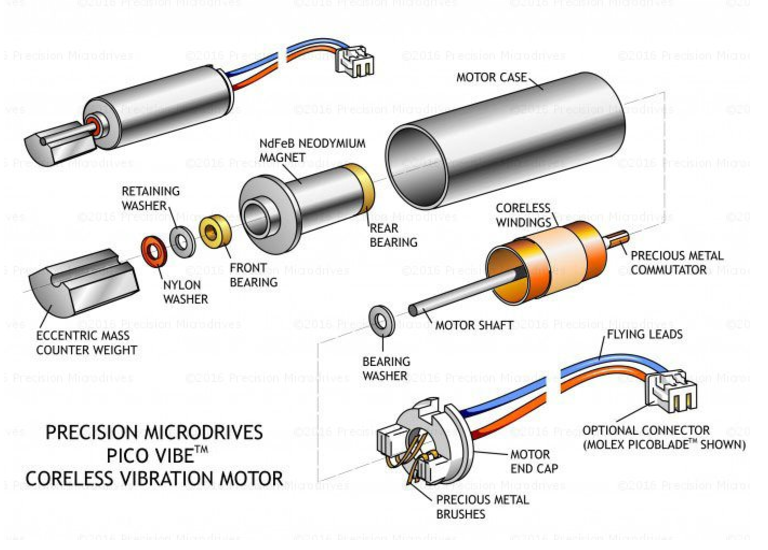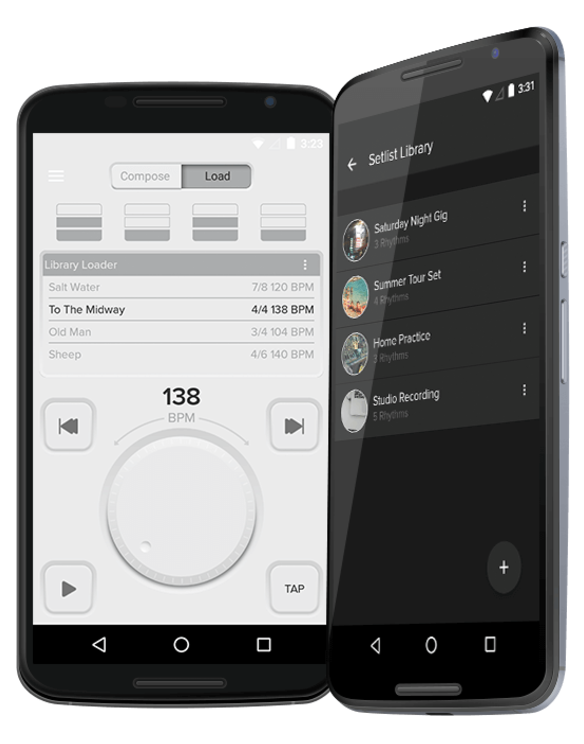By Matt Dorland
Published January 17, 2016
Introduction
The Soundbrenner Pulse is the world’s first wearable metronome designed for professional musicians. A metronome is a tool used by musicians that produces a regular audible click at a selected speed to set a steady beat, or tempo. A steady tempo is essential to the rhythmic integrity of nearly every type of music, and is especially important when multiple musicians are playing together. The Soundbrenner Pulse enables musicians to better internalize a steady pulse through the use of haptic feedback.
Traditional metronomes produce only two types of stimuli: audio, in the form of a click or tick, and visual, such as a wand swaying back and forth in an analog metronome or a blinking LED light in a digital one. For many musicians, however, these stimuli are not strong enough to help them successfully entrain to (fall into synchronization with) the beat. The Soundbrenner Pulse addresses this issue by adding a third type of stimulus: haptic, or tactile, feedback in the form of vibrations that can be felt on the wearer’s skin. The wearer can feel the strong, vibrating pulse in a variety of contexts in which audio or visual cues would be too weak, such as during a loud, live performance on a dark stage.
The Soundbrenner Pulse looks similar to a large wristwatch: it consists of a shallow, black circular body 1.75” in diameter with a haptically interactive face, attached to an adjustable silicone strap for wearing (Figure 1). Users can wear the device anywhere on the arm or leg, depending on the needs of the individual. Users can also control the device by both its interactive face and a corresponding application for a smartphone or tablet. The app allows for the wireless synchronization of up to five devices for ensemble use (Soundbrenner).

Figure 1. The Soundbrenner Pulse features a watchface design with an adjustable silicone strap. Image source: Soundbrenner.com.
How it Works
The Soundbrenner Pulse works by delivering a vibrating pulse at a selected tempo to the wearer’s skin. Users can input their desired tempo in one of two ways: either tapping a regular pulse on the device’s face or selecting a BPM (beats per minute) number on the smartphone application (Soundbrenner). The device then produces a short vibration at regular intervals according to the selected speed. Because the device is worn against the skin, the wearer can literally “feel the beat” as opposed to relying solely on an audio or visual cue. Users can wear the device on the part of the body responsible for keeping a steady rhythm while playing an instrument, such as on the arm for guitarists or the lower leg for drummers playing a kick drum.
Hardware
The device consists of a circular body composed of a black plastic casing. The round, minimalist face displays the Soundbrenner logo and features a capacitive touch sensor for interactive tapping (Soundbrenner). A rotating click-wheel surrounds the face and allows users to control the BPM once it is set. The casing houses a haptic actuator (discussed below) and a lithium polymer battery, which provides approximately 6 hours of continuous use on a single charge (Soundbrenner). A long battery life means that users can have long practices sessions with the device without stopping to recharge it.
Key Component: Eccentric Rotating Mass
The most unique feature of the Soundbrenner Pulse is its ability to deliver haptic feedback to the wearer. The device creates haptic feedback with a haptic actuator, or motor, inside the main body of the device. This type of motor is known as an eccentric rotating mass, or ERM. Because the device serves primarily to produce vibrations, a large amount of internal space allowed the developers to include a powerful motor, which produces vibrations 7 times stronger than those in the average smartphone (Soundbrenner).
ERMs are most commonly found in pagers, smartphones, handheld medical instruments, and other personal devices. The typical ERM, shown in Figure 2, consists of a cylindrical metal casing surrounding a small, 1.5-3 volt direct current motor and drive shaft. Outside the main casing is an unbalanced weight, or eccentric mass, attached to the drive shaft. When rotated at high velocity the eccentric mass becomes an asymmetrical force, causing a displacement of the motor housing. When mounted inside a device, this displacement causes the entire device to vibrate (“Eccentric Rotating Mass Vibration Motors - ERMs”).

Figure 2. An exploded view of an eccentric rotating mass motor like the one found in the Soundbrenner Pulse. Image source: Precisionmicrodrives.com.
Audio and Visual Features
Besides its hallmark haptic feature, the Soundbrenner Pulse includes an audio metronome that users can turn on or off from the smartphone app. This feature is similar to a traditional metronome but with enhanced customization: users can choose from six different click sounds as well as adjust the volume of the click. One drawback to the device is that it has no external speakers. However, with the use of the companion app, users can utilize the audio click through the smartphone’s external speakers, a headphone jack, or another kind of speaker connected to the phone. Users can then benefit from the combined haptic and audio cues.
The Soundbrenner’s unique design can also benefit visual learners. The logo and wheel on the device’s face are lit with LEDs which users can customize to glow white (default), green, pink, or blue. Depending on the user’s preference the light will flash with the pulse, matching the vibrations, or can be turned off with “discrete mode” (Soundbrenner).
The combined use of the haptic, audio, and visual features of the device provides a unique and unparalleled user experience. Educational psychologists James Minogue and M. Gail Jones cite research suggesting that the visual and haptic modalities may overlap in the brain, forming a dual memory-coding system that can assist in learning (331). The Soundbrenner takes advantage of this opportunity by providing the user with the optional audio and visual features.
Companion Application
The included companion application for smartphone or tablet, simply titled “The Metronome” greatly expands the user capabilities (Figure 3). Users can configure the app’s visual interface to either a light or dark display theme, which allows for discreet use of the device while on a dark stage.
Users can select a tempo on a dial, or tap a tempo on the touchscreen in a similar way to using the Soundbrenner device’s interactive face. From there, users can select a time signature (the organization of strong and weak beats into measures), subdivisions of the beat, and accents. The device includes tempos ranging from 30 to 300 BPM (Soundbrenner).

Figure 3. “The Metronome” companion application showing the light and dark display themes and various features. Image source: Soundbrenner.com.
The app allows users to customize the haptic profile of the wearable device. Nine different types of vibrations are available, with short, medium, or long durations combined with either weak, regular, or strong vibrations. The app’s library feature allows users to create and save custom rhythms, which can then be organized into playlists and played through the wearable device.
For advanced users, the app can connect with a DAW (Digital Audio Workstation) such as Pro Tools on Mac OS X. The wearable device will then match any preset tempos in the DAW. Finally, the app has a multi-player synchronization function that can control up to five Soundbrenner devices from one phone, allowing groups to utilize all the device’s unique features together (Soundbrenner).
Summary
The Soundbrenner Pulse is a unique wearable metronome that can improve musicians’ rhythmic accuracy through the use of haptic feedback. The ERM inside the device produces strong vibrations which are felt on the wearer’s skin. Together with the audio and visual features, the device delivers a three-way stimulation that can assist musicians in a variety of performance contexts. The companion application allows for further customization of the device’s features as well as small ensemble use and DAW compatibility.
Works Cited
“Eccentric Rotating Mass Vibration Motors - ERMs.” Precision Microdrives, 2016, www.precisionmicrodrives.com/vibration-motors/eccentric-rotating-mass-vibration-motors-erms. Accessed 15 October 2016.
Minogue, James, and M. Gail Jones. “Haptics in Education: Exploring an Untapped Sensory Modality.” Review of Educational Research, vol. 76, no. 3, 2006, pp. 317-348. JSTOR, www.jstor.org/stable/4124421.
Soundbrenner Pulse. Soundbrenner Limited, 2016, www.soundbrenner.com/soundbrenner-pulse/. Accessed 16 October 2016.